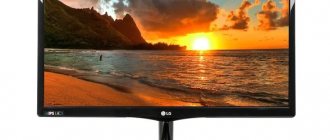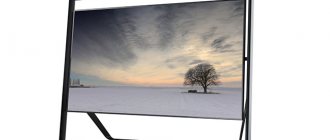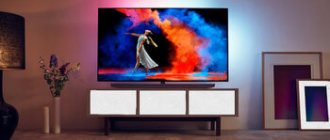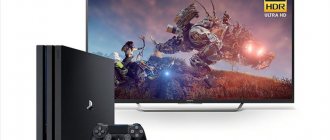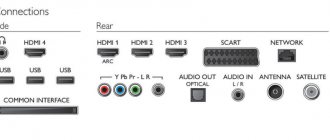TOP models in the 50–55 inch category
The 50–55-inch diagonal can be considered one of the most popular. It allows you to comfortably watch movies on the big screen and play games on your console with complete immersion. The optimal distance for viewing such TVs is 190–260 cm.
LG 55UK6450
pros
- Intelligent voice recognition and owner commands
- Expanded interface: four HDMI inputs, two USB, Bluetooth, Wi-Fi, headphone jack
- Surround effect
- The “LG Channels Plus” option allows you to additionally view more than 200 foreign and domestic channels
- Supports HDR standards for highly detailed images
Minuses
- Due to the significant thickness of the housing (89 mm), the device protrudes significantly above the wall surface when mounted on a wall
The 55″ (139 m) diagonal TV in a classic black case is equipped with one massive stand. Two speakers with a power of 10 W each provide good audibility even in a large room. You can select channels and control the TV using voice commands or using a multi-brand remote control, which has a separate button to enter the IVI online cinema.
Samsung UE55NU7300U
pros
- Curved screen creates a panoramic effect
- Auto Depth Enhancer technology automatically enhances the contrast of central objects compared to the background
- TimeShift option available and recording of online programs to a USB drive
- Cloud service Samsung Cloud allows you to synchronize your TV with your smartphone to view photos
Minuses
- The model takes up a lot of space due to its wide legs and arched shape.
- There is no Bluetooth connection
The 55″ (139 cm) diagonal TV primarily attracts attention with its curved shape and thin body. HDMI and USB connectors are located not only on the rear panel, but also on the side, which makes them easier to access when wall-mounting the TV. The model supports HDR standards, providing high quality images in both static and dynamic scenes.
Sony KD-55XF9005
pros
- Deep black color
- Bright, rich, natural colors
- Supports dynamic content HDR10, HLG
- Local Dimming system provides dimming in 48 independent areas, increasing contrast
- Built-in sensor increases screen brightness depending on room lighting
- You can record your favorite program to an external drive
- Front Surround S-Force technology creates surround sound with just two 10W speakers
- Convenient placement of HDMI and USB ports
Minuses
- Picture quality decreases when viewed at an angle
The 55″ (139 cm) TV has successfully occupied the niche between the economy class and the premium segment. On the back of the legs, which can be folded outwards or inwards, there are grooves for cable management. For computer games, the Motion Blur option is available, which allows you to blur the image at the edges, concentrating it in the center, to enhance the dynamics of the scene. This TV was one of the first to introduce X-Motion Clarity technology, which reduces motion blur.
Comparison table of the best 4K TVs
| Name | Main characteristics | Price |
| Samsung UE55NU7300U | 55 inches, with a curvature radius of 4200 millimeters, HDR support, two ten-watt Dolby Digital Plus speakers, digital noise reduction, Smart TV functionality. | ₽ 44 990 |
| LG 43UJ631V | There is a Smart TV, the ability to scale images to 4K resolution, full control via a smartphone, digital noise reduction and other standard goodies in place. | ₽ 24 290 |
| Haier LE65U6700U | 65-inch diagonal, there is a Smart TV, a recording function from TV to a USB device, two powerful 15-watt speakers with NICAM stereo technology. | ₽ 72 990 |
| Sharp LC-43CUF8472ES | With a diagonal of 43 inches, speakers from Harman-Kardon, radio remote control, digital noise reduction, the ability to record TV programs on a flash drive, Smart TV functionality. | ₽ 20 990 |
| Sharp LC-40UG7252E | 40-inch diagonal, radio remote control, digital noise reduction, smart TV, image scaling to Ultra HD, two speakers of 10 watts each from Harman-Kardon. | ₽ 24 990 |
| Sony KD-43XF7005 | Bright screen with 200 Hz technology, HDR support, digital noise reduction and image scaling to Ultra HD resolution, two 10-watt speakers. | ₽ 43 990 |
| Panasonic TX-43FXR610 | Featuring built-in Wi-Fi, Smart-TV functions and the ability to control from a smartphone, 1300 hertz technology captures even the most dynamic scenes without artifacts. | ₽ 35 990 |
| Samsung UE43LS03NAU | Beautiful design, Smart TV, HDR, digital noise reduction, 43 inches diagonal. | ₽ 64 990 |
| LG 75UH855V | With a diagonal of 75 inches (190 centimeters - above the average male height!), Smart TV, control from a smartphone and an NFC chip, speakers with Ultra Surround technology produce 20 watts of power each. | ₽ 110 500 |
| Samsung UE49NU7670U | With a 49-inch diagonal curved screen, there is Smart TV, HDR support and digital noise reduction. | ₽ 49 990 |
Which 4K TV is best to buy in 2021?
Consequently, users are offered a wide range of models with the specified resolution to choose from. There are budget and premium solutions that differ not only in functionality, but also in the quality of the matrix, backlight, and other technical characteristics. We tried to find the best solutions in different price categories, taking into account the most popular sizes. If you don’t know which 4K TV to buy, we recommend paying attention to reviews of each model, of which there are many on the Internet today. Opinion “Price/Quality”:
- The best inexpensive 4K TV is Xiaomi Mi TV 4A 55 T2;
- A good 50-inch model is Philips 50PUS8505;
- Best 49-inch 4K TV – NanoCell LG 49NANO866;
- Budget model on an OLED matrix – TCL 55C717;
- The clearest and most functional 4K TV is QLED Samsung QE55Q60TAU.
How to choose a good TV with Smart TV?
It comes only from the descriptions of TVs presented on the websites of manufacturers or their dealers - a very dubious approach if you don’t know how to choose a good 4K TV. Often one has to read ridiculous praise, as well as unsubstantiated records for a number of parameters that are of no value at all. We recommend using a neutral resource. In particular, you can compare the key parameters of the models you like on D isplay S specifications , but before that we would like to note what characteristics you should look at:
- Matrix. The standard in the field of constructing large panels is the OLED matrix, which guarantees the clearest picture possible, but you need to take into account that they are also different, which the manufacturers do not say. This must be taken into account, since budget solutions can burn out (if you don’t turn off the TV, the same thing happens with the channel name icons in the corner). That is, over time, a pattern may remain on the panel. IPS matrices transmit more light than VA, but they have a better viewing angle even than premium QLEDs. However, we give second place in terms of picture to VA.
- Backlight. There are three types including Full Array, Edge and Direct. The first option is considered the simplest, and is combined with budget light filters. The second option involves using lighting on the sides (built into the frame). In the latter case, diffusers are used, and the backlight is installed from behind. It is worth saying that the more complex the backlight, the better the filter should be. Most often, budget models receive a weak combination of filters and backlighting, which provides for low output brightness.
- Refresh rate - the higher this indicator, the smoother and more realistic the picture is. If you like to watch action movies, then it is better to focus on models with a frequency of 100 Hz or more.
- Brightness. This parameter depends on the quality of the backlight, as well as filters. It’s worth saying right away that even the presence of HDR in budget models does not work fully if the indicator is below 500 cd per square meter.
- Productivity . This parameter captures the amount of RAM and processor, but is most easily expressed in the image refresh rate, so we won’t describe possible configurations.
Tips for choosing a Smart TV from experts
- Which 4K TV manufacturer is better ? This is a subjective question, the answer to which depends on the budget and preferences of the user. The leaders in the production of 4K TVs are companies such as Sony, Samsung and LG. If you are interested in the VA matrix, then the advantage is in favor of the first brand. At the same time, different lines of SMART TVs differ in terms of functionality, proprietary technologies and other characteristics. Therefore, we recommend comparing the models you like on the official DisplaySpecifications resource.
- How does the QLED matrix differ from IPS and OLED ? The overwhelming number of experts believe that this is just a marketing ploy. Essentially, the QLED matrix is a premium VA technology with an expensive filter. Unfortunately, due to the fact that many users and “experts” do not dive into this issue, there is a lot of misleading information on the Internet. In terms of color rendering, the OLED matrix is still better, as well as in the field of viewing angle. Obviously, this technology used in premium Samsung solutions is better than its IPS counterparts, but also more expensive.
- How much does a good 4K TV cost ? Depends on the selected matrix, its level, panel size, manufacturer, refresh rate and a number of other parameters. The cheapest solutions (among decent 4K TVs) are offered by Xiaomi. Most of the marketing is in Samsung and LG, who like to constantly come up with intricate names for their new products just because they have introduced a better filter. However, these brands offer the largest range of models and often surpass Sony in terms of price/quality ratio. The latter brand is a leader in the production of OLED TVs, as it uses really expensive but high-quality technologies.
- What characteristics should you consider when choosing a 4K TV ? It is important to understand that technical parameters alone will not give you a good idea of the quality of the picture. It is necessary to take into account not only the type of matrix, but also what filters are installed. For example, LG’s premium IPS matrices are called NanoCell. At the same time, budget OLED displays can burn out. It is important to compare models using specialized resources. As for the main points, we do not recommend buying a TV with a diagonal of 49 inches or more with a frequency of less than 100 Hz; do not neglect the quality of the backlight (if not an OLED matrix) and the brightness level. Please note that having a low brightness level means the backlight will burn out quickly when using the maximum values. Other key parameters are described in our rating.
Which is better, 4K or Full HD TV?
Innovative technology is slowly but surely gaining positions in the modern market, but there are not many people willing to use it yet.
This is due to the high cost of Ultra-HD TVs and the limited amount of content presented . In addition, the realities of our lives and the electronics market in Russia are still poorly adapted for the active use of such devices and viewing videos in ultra-high resolution.
Maxim Kirichenko
Buying a 4K TV entails a number of difficulties . To fully use such a device, you need high-speed Internet and a special HDMI power cable (if you want to capture images from a computer). In addition, the user will have to spend a lot of time searching for suitable content, but by now, there are already many online services that provide all media content in 4K resolution.

